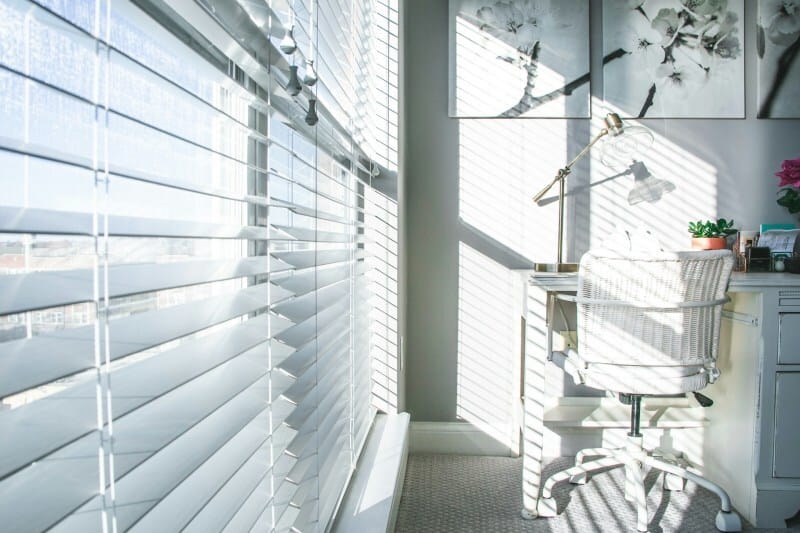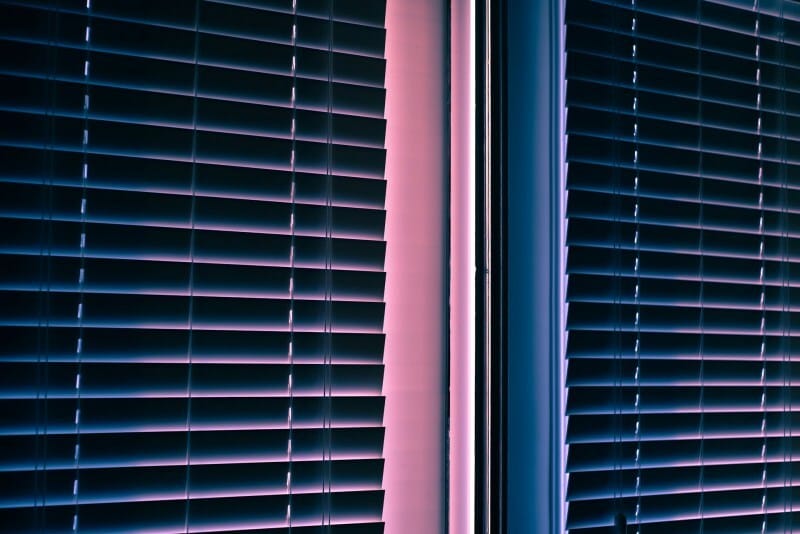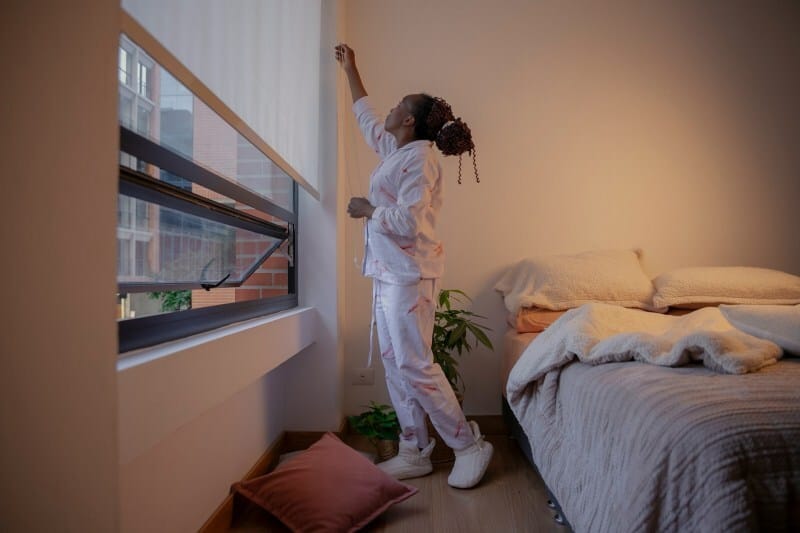Shift workers often struggle with poor sleep due to light exposure during daytime rest hours. Simple window modifications – such as blackout blinds, layered coverings, or thermal curtains – can significantly improve sleep quality by blocking sunlight and regulating room temperature. Combined with strong sleep hygiene practices, these changes can support better shift work fatigue management and reduce symptoms of shift work sleep disorder.

Table of Contents
Top Window Hacks to Support Restful Daytime Sleep
Complementary Shift Work Sleep Strategies
Final Thoughts: Small Changes, Big Sleep Gains
If you’ve ever tried to sleep at 10 a.m. after a night shift, you know how unforgiving daylight can be. Sunlight streaming through windows doesn’t just wake you up – it disrupts your circadian rhythm, making it harder to fall and stay asleep. For the nearly 1.8 million Canadians working non-traditional hours, managing light exposure isn’t a luxury; it’s a necessity for health and performance.
With a few strategic tweaks – especially using window coverings designed to block light and insulate rooms – you can transform your bedroom into a sleep sanctuary, no matter the hour. In fact, pairing smart window solutions with proven shift work sleep tips can significantly ease shift work fatigue management and protect your long-term well-being. Affordable blinds are a practical first step toward creating that ideal sleep environment without breaking the bank.

Top Window Hacks to Support Restful Daytime Sleep
Creating a sleep-friendly environment during daylight hours starts at the window. For shift workers, even a sliver of morning sun can derail rest, so the goal is total light control without sacrificing comfort or style. Below are five proven, budget-conscious window hacks that make a measurable difference in sleep quality – especially when paired with strong shift work sleep tips.
Install Blackout or Room-Darkening Blinds
Blackout blinds are engineered to block 99–100% of external light, making them the gold standard for daytime sleepers. Unlike standard blinds, which often leave gaps at the sides or top, custom-fit blackout options hug the window frame precisely. Look for models with side channels or wrap-around brackets that seal light leaks.
Roller, cellular, and vertical styles all come in blackout variants – choose based on your window shape and aesthetic preference. For best results, mount the blind outside the window recess to cover the entire frame.

Layer Window Treatments for Maximum Darkness
Sometimes one layer isn’t enough. Combining blackout blinds with heavy blackout curtains adds redundancy and improves insulation. This “double-layer” approach is especially effective for large windows or rooms with reflective surfaces (like mirrors or light-coloured walls) that bounce residual light around. The added fabric also dampens street noise – a bonus for urban shift workers.
To help you choose, here’s a quick comparison of common window covering types:
*Effectiveness depends on fabric weight and proper overlap.
Use Thermal or Insulated Curtains
Temperature plays a bigger role in sleep than many realize. The ideal bedroom temperature for sleep is between 16°C and 19°C – and thermal curtains help maintain that range year-round. These curtains feature a foam or acrylic backing that reduces heat transfer, keeping rooms cooler in summer and warmer in winter.
Many thermal options also include blackout lining, offering dual benefits. Look for labels that mention “energy-efficient” or “insulated” – common features in Canadian-made window coverings designed for our climate.
Seal Light Leaks Around Frames and Edges

Even the best blinds can fail if light sneaks in around the edges. Common culprits include gaps at the top, sides, or where blinds meet the wall. Simple fixes include:
Applying adhesive-backed foam tape along the window frame
Using Velcro strips to attach blackout fabric flaps to the wall beside the blind
Installing a DIY cornice board (a fabric-covered wooden frame) above the window to block overhead light
These low-cost tweaks can eliminate 90% of residual light intrusion.
Automate Your Blinds for Consistency
Consistency is key in sleep hygiene for shift workers. If you’re too exhausted after a shift to close your blinds manually, consider motorized options. Modern motorized blinds can be scheduled via app or smart home system (like Alexa or Google Home) to close automatically at your bedtime – ensuring your room is always dark when you need it.
While this option costs more upfront, it removes human error from the equation and supports long-term shift work fatigue management by reinforcing routine.

Complementary Shift Work Sleep Strategies
While optimizing your windows is a powerful first step, lasting improvements in rest require a holistic approach to shift work sleep tips. Light control sets the stage – but your habits, routines, and environment determine whether you achieve deep, restorative sleep. Below are five non-window strategies that work hand-in-hand with your blackout setup to support better recovery and reduce shift work fatigue management challenges.
Stick to a Consistent Sleep ScheduleEven on days off, try to go to bed and wake up within a two-hour window of your usual shift schedule. This consistency helps stabilize your circadian rhythm and reduces the “jet lag” effect many shift workers experience.
Create a Pre-Sleep Wind-Down RoutineSignal to your body that it’s time to rest – regardless of the clock – by dimming indoor lights, avoiding screens 30–60 minutes before bed, and engaging in calming activities like reading (with a warm-toned lamp) or light stretching.
Use White Noise or EarplugsDaytime sleep often coincides with household or street noise. A white noise machine or high-fidelity earplugs can mask disruptive sounds and improve sleep continuity, especially in urban Canadian neighbourhoods.
Limit Caffeine After Mid-ShiftIf you work nights, avoid caffeine in the last 4–6 hours of your shift. While it helps with alertness early on, late consumption can delay sleep onset and reduce total sleep time – even in a perfectly dark room.
Reserve Your Bedroom for Sleep OnlyAvoid eating, watching TV, or working in bed. This mental association strengthens your brain’s cue that the bedroom = rest, making it easier to fall asleep quickly during unconventional hours.
These practices amplify the benefits of your darkened sleep environment. Together, they form a robust framework for managing shift work sleep disorder symptoms – not by fighting your schedule, but by adapting your habits to support it.
Final Thoughts: Small Changes, Big Sleep Gains
For shift workers across Canada, quality sleep isn’t a luxury – it’s a necessity for health, safety, and daily performance. While the challenges of shift work sleep disorder symptoms are real, they’re not insurmountable. Often, the most impactful solutions are surprisingly simple: blocking sunlight at the window, maintaining a cool and quiet bedroom, and sticking to consistent routines.
By combining smart window modifications with proven shift work sleep tips, you create an environment where rest becomes possible – even during the brightest hours of the day. These adjustments support long-term shift work fatigue management and reinforce healthy sleep hygiene for shift workers, helping you feel more alert on the job and more refreshed at home.
Remember, you don’t need a complete home renovation to make a difference. Even one well-chosen upgrade – like properly fitted, light-blocking coverings – can transform your sleep quality overnight. When your body gets the rest it needs, your resilience, mood, and overall well-being follow. And in the demanding world of shift work, that’s not just a win – it’s essential.
The post Window Hacks for Shift Workers appeared first on Moss and Fog.
